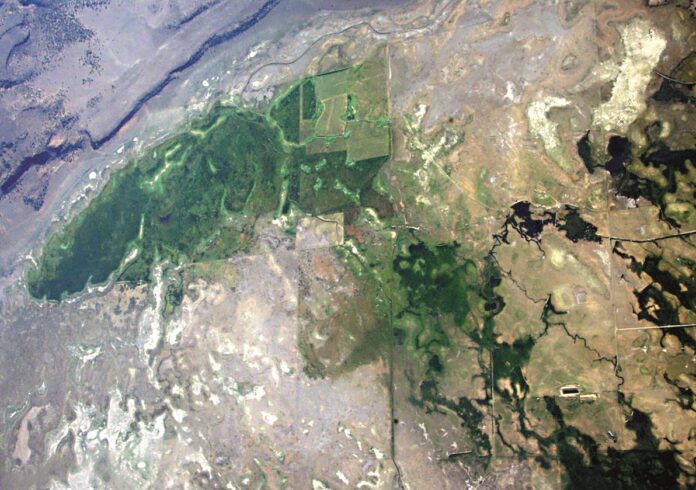Earth Observation has become a powerful tool for water management that is transforming the way water professionals respond to water cycle challenges. Erin Jordan explains how PrimeWater, an international project involving IWA, has put the needs of clients at the heart of its applications.
Funded by the European Union’s Horizon 2020 Research and Innovation Programme, PrimeWater has been a game changing project. Its aim is to develop Earth Observation (EO) products that are tailored to enhance user experience and find solutions that seamlessly support day-to-day activities across broad needs.
A project with global reach
The three-year project, now complete, was successfully guided by an international consortium of partners, bringing together a team of research organisations, SMEs, water associations, private enterprises and public water authorities from Europe, the USA and Australia. The consortium drew from a wide spectrum of expertise, embracing EO science and technology, water science, information and communications technology, modelling, integrated water resources management, social sciences, consultation, and systems for circulating and sharing information with end users.
IWA became a key partner in the PrimeWater project in December 2019. As a leading global water association with an extensive network of water professionals, utilities, and policymakers, IWA has played a vital role in facilitating communication and knowledge exchange among the project’s participants. It has taken a lead in communication and dissemination activities, assisting in the identification of end user needs, and supporting efforts to reach new markets through the establishment of a Community of Practice (CoP).
Expanding on advanced EO data products, integrated with additional data sources and diagnostic modelling tools, PrimeWater generated information on the effects of upstream changes on future water quality and quantity, to inform public and private sector decision-making with regards to situational intelligence, enhanced predictive and early warning capabilities, and the adaptive management of water resources.
Four full-scale international case studies were undertaken, located in Europe, the USA, and Australia. These case studies were developed to challenge the transferability of PrimeWater applications in diverse water catchment systems and sectors. Each case study approached a different aspect of water circle management, including water resources management, environmental protection, and potable water supplies, with a focus on the adaptability and functionality of EO for each user’s requirements.
PrimeWater’s Operational Platform
Over the course of the project, the consortium produced a plethora of impressive results, most notably the PrimeWater Operational Platform. This platform has numerous uses and benefits, and is designed to empower decision-makers with real-time data and insights to support sustainable water management and increase resilience.
Preserving water quality is crucial for safeguarding human health and maintaining the integrity of aquatic ecosystems. PrimeWater’s platform excels in water quality monitoring, enabling the detection of pollution sources and the assessment of water quality trends. The platform’s ability to identify water quality issues allows for swift mitigation measures, protecting both environmental integrity and public health.
The platform’s central feature lies in its capacity to provide real-time monitoring and assessment of water resources. Through the integration of data from satellites, remote sensing, and in-situ sensors, the platform offers a comprehensive view of critical water parameters, such as water levels, flow rates, and water quality indicators. This real-time data equips water managers and policymakers with up-to-date information, enabling them to respond quickly and effectively to emerging water crises, such as floods, droughts, and pollution incidents.
Effective early warning systems play a vital role in minimising the impacts of natural disasters and extreme weather events. The platform’s real-time monitoring capabilities enable the development of early warning systems for floods and other water-related disasters. By providing advanced notice of potential hazards, it empowers authorities to initiate evacuation measures, deploy resources, and implement disaster preparedness plans, significantly reducing the human and economic toll of these events.
Equitable access
By aggregating and processing vast amounts of data, the platform facilitates improved, more informed water resource management. Water managers can access comprehensive and accurate information, enabling them to optimise the allocation of water resources, and so ensure the equitable distribution of water among different sectors and users. EO applications play a critical role in enabling efficient resource allocation by providing a comprehensive view of water availability and demand across different regions. The platform’s insights can help water managers identify inefficiencies, manage water demand, and develop targeted conservation strategies. With a clear understanding of water availability and usage patterns, policymakers can make well-informed decisions regarding water allocation, considering social, economic and environmental factors, ensuring that each sector’s needs are met, and promoting societal stability and economic growth.
Improving resilience
Climate change presents numerous challenges to water resource management, including altered precipitation patterns and more frequent and intense weather events. EO applications are valuable tools for assessing and adapting to these changes. PrimeWater’s platform assists in climate change adaptation by providing data to improve understanding of shifting hydrological patterns, including changes in precipitation patterns, snowmelt timing, and alterations in river flow, improving predictions of future water availability, so enabling stakeholders to develop proactive strategies to adapt to changing climatic conditions, supporting future water security through the development of climate-resilient water management plans.
The data provided by the platform can be used to support decision-making and policy formulation, offering valuable insights to policymakers and water managers, enabling authorities to design evidence-based regulations, conservation measures, and water allocation policies. In addition, the platform’s accessible and user-friendly data visualisation, encourages the involvement of stakeholders, such as local communities, water utilities and environmental organisations, to collaborate efforts, based on shared data and information, creating a more inclusive and holistic approach to water resource management. By engaging end users in the co-creation of adaptation measures, a sense of ownership and commitment to sustainable strategies is fostered, so improving the prospects for successful implementation.
Applications tailored to the end user
Notable results from the project include the collation of the perspectives of end users with regards to the potential applications of EO for water management. Consortium partner, the Burgundy School of Business, designed a comprehensive survey to capture the true feelings and opinions of end users with respect to purchasing and applying EO tools and services for their day-to-day tasks. These insights have helped to improve the quality and effectiveness of the services provided.
End users in the sphere of water management encompass a diverse group, including water utilities, government agencies, farmers, industries, and local communities. Each stakeholder has distinct requirements, challenges and priorities related to water resource management. Understanding their perspectives is crucial to enable EO applications and services to be tailored to meet specific needs.
Actionable information that directly addresses the water challenges of the end user is required. Water utilities, for example, may prioritise real-time monitoring of water levels and quality to optimise distribution networks and anticipate supply disruptions, while farmers may be interested in seasonal forecasts to plan irrigation schedules and maximise crop yields. Engaging end users allows EO providers to develop customised solutions that cater to their specific demands, ensuring greater relevance and adoption.
By integrating EO applications and services in water management systems, managers are empowered with accurate and timely information. EO technologies provide data on various water parameters, including precipitation, river flow, groundwater levels, and water quality, supporting informed decision-making. Access to such data enables stakeholders to make proactive choices, responding effectively to water-related challenges and mitigating potential risks. For example, during droughts, farmers can adjust their irrigation schedules based on satellite-derived soil moisture data, optimising water use and crop productivity. Similarly, water authorities can implement targeted conservation measures, such as water use restrictions, based on EO assessments of water availability and demand. These actions contribute to better resource management, reducing waste and enhancing water use efficiency.
Knowledge sharing
The impact of community participation in water management should not be underestimated. Local communities play an important part in water management and their input is invaluable in identifying water-related issues and proposing context specific solutions. Participatory approaches that involve local communities in data collection, interpretation and decision-making empower them to take ownership of water management initiatives. Such collaboration fosters trust, transparency and cooperation between various stakeholders, strengthening the overall resilience of water management practices. This engagement will help ensure that EO technologies become and remain powerful tools for safeguarding our water systems for current and future generations.
EO4WAT
Fundamental to IWA’s role in the PrimeWater project was the establishment of the Earth Observation for Water Management Community of Practice (EO4WAT), created to bring together a diverse group of water professionals with a shared interest in applying EO technologies to water management.
Still active, EO4WAT serves as a collaborative platform, fostering partnerships to facilitate the sharing of knowledge, building capacity and advocacy for the integration of EO applications in water management practices. Through its endorsement and participation, IWA has contributed to the credibility and effectiveness of the community, attracting a wide range of stakeholders to engage in discussion and learn from one another’s experience. EO4WAT initiatives include training workshops, webinars, and community meetings, which aim to bridge any gaps in knowledge and equip water professionals with the necessary expertise to interpret and apply EO data effectively. This comes at an important time, as human capital will be critical if the benefits of EO technologies are to be maximised, ensuring that their application is implemented successfully and the greatest rewards are secured.
EO4WAT works to promote the integration of EO technologies into water policies and management frameworks at national and regional level, raising awareness of EO’s crucial role in the management of water resources and helping to drive broader adoption of EO with the aim of fostering more resilient and sustainable approaches to global water management.
An invaluable tool
By harnessing the potential of EO technologies, PrimeWater’s EO-supported platform has the power to contribute significantly to sustainable water management, climate change adaptation, and the preservation of our planet’s most precious resource. The PrimeWater Operational Platform stands as a remarkable achievement in water resource management. With its capabilities, the platform has become an invaluable tool for water managers and policymakers worldwide. The project’s commitment to gaining understanding of the needs and priorities of a wide and varied group of stakeholders has enabled EO solutions to be customised, making an important contribution to global water security. •
More information:
Find out more about EO4WAT at iwa-network.org/projects/earth-observation-for-water-management-community-of-practice








